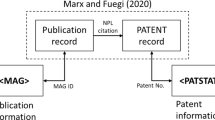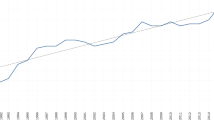Abstract
In this paper we investigate — at a country level — the relationship between the science intensity of patents and technological productivity, taking into account differences in terms of scientific productivity. The number of non patent references in patents is considered as an approximation of the science intensity of technology whereas a country’s technological and scientific performance is measured in terms of productivity (i.e., number of patents and publications per capita). We use USPTO patent-data pertaining to biotechnology for 20 countries covering the time period 1992–1999. Our findings reveal mutual positive relationships between scientific and technological productivity for the respective countries involved. At the same time technological productivity is associated positively with the science intensity of patients. These results are confirmed when introducing time effects. These observations corroborate the construct validity of science intensity as a distinctive indicator and suggest its usefulness for assessing science and technology dynamics.
Similar content being viewed by others
References
Andersen, B. (2001), Technological Change and the Evolution of Corporate Innovation. Edward Elgar Publishing.
Baum, J. A. C., Calabrese, T., Silverman, B. S. (2000), Don’t go it alone: alliance network composition and startups’ performance in Canadian biotechnology. Strategic Management Journal, 21(3): 267–294.
Blalock, H. (1961), Causal Inferences in Nonexperimental Research. Chapel Hill, NC: UNC Press.
Callaert, J., Van Looy, B., Verbeek, A., Debackere, K., Thijs, B. (2006), Traces of prior art: A systematic analysis of other references found within the uspto and epo patent system. Scientometrics, 69(1): 3–20.
Collins, P., Wyatt, S. (1988), Citations in patents to the basic research literature. Research Policy, 17: 65–74.
Davis, J. A. (1985), The Logic of Causal Order. Quantitative applications in the social sciences series, no. 55. Thousand Oaks, CA: Sage Publications. pp. 38–44 provide a non-technical introduction to partial correlation inferences.
Deeds, D. L., Hill, C. W. (1996), Strategic alliances and the rate of new product development: an empirical study of entrepreneurial biotechnology firms. Journal of Business Venturing, 11: 41–55.
Dernis H., Guellec, D., van Pottelsberghe de la Potterie, B. (2001), Using patent counts for crosscountry comparisons of technology output, STI Review, OECD, 27: 129–146.
Etzkowitz, H., Leydesdorff, L. (1997), Introduction to special issue on science policy dimensions of the Triple Helix of university-industry-government relations. Science and Public Policy, 24(1): 2–5.
Etzkowitz, H., Leydesdorff, L. (1998), The endless transition: A ‘Triple Helix’ of university-industry-government relations. Minerva, 36: 203–208.
Etzkowitz, H., Leydesdorff, L. (2000), The dynamics of innovation: from National Systems and ‘Mode 2’ to a Triple Helix of university-industry-government relations. Research Policy, 29: 109–123.
Guellec, D., van Pottelsberghe de la Potterie, B. (2001), The internationalisation of technology analysed with patent data, Research Policy, 30(8): 1253–1266.
Griliches, Z. (1990), Patent statistics as economic indicators: A survey. Journal of Economic Literature, 28: 1661–1707.
Grupp, H., Schmoch, U. (1992), Perception of scientification of innovation as measured by referencing between patents and papers. In: H. Grupp (Ed.), Dynamics of Science-Based Innovations, Springer Publishers, Berlin/Heidelberg, pp. 73–128.
Leydesdorff, L., Etzkowitz, H. (1996), Emergence of a Triple Helix of university-industry-government relations. Science and Public Policy, 23(5): 279–286.
Leydesdorff, L., Etzkowitz, H. (1998), Triple Helix of innovation: Introduction. Science and Public Policy, 25(6): 358–364.
McCulloch, R. (1980), International indicators of science and technology — how does the US compare? Scientometrics, 2(5–6): 355–367.
McMillan, S., Narin, F., Deeds, D. (2000), An analysis of the critical role of public science in innovation: The case of biotechnology. Research Policy, 29: 1–8.
Meyer, M. (2000), Patent citations in a novel field of technology — What can they tell about interactions between emerging communities of science and technology. Scientometrics, 48(2): 151–178.
Meyer, M. (2000b), Does science push technology? Patents citing scientific literature. Research Policy, 29: 409–434.
Meyer-Krahmer, F., Schmoch, U. (1998), Science-based technologies: University-industry interactions in four fields. Research Policy, 27: 835–851.
Michel, J., Bettels, B. (2001), Patent citation analysis: A closer look at the basic input data from patent search reports. Scientometrics, 51(1): 185–201.
Narin, F., Noma, E. (1985), Is technology becoming science? Scientometrics, 7: 369–381.
Narin, F., Olivastro, D. (1992), Status report: Linkage between technology and science. Research Policy, 21: 237–249.
Narin F., Olivastro D. (1998), Linkage between patents and papers: an interim EPO/US comparison, Scientometrics, 41: 51–59.
Narin, F., Hamilton, K., Olivastro, D. (1997), The increasing linkage between US technology and public science. Research Policy, 26: 317–330.
Nelson, R. R. (Ed.) (1993), National Innovation Systems: A Comparative Analysis. Oxford University Press.
OECD (1994), The Measurement of Scientific and Technological Activities: Using Patent Data as Science and Technology Indicators. Patent Manual 1994, Paris.
OECD (2001) STI Scoreboard 2001, OECD, Paris.
Porter, M. (1995), The Competitive Advantage of Nations, New York. The Free Press.
Price, D. De Solla (1963), Little Science, Big Science. Columbia University Press.
Price, D. De Solla (1965), Is technology historically independent of Science? A study in statistical historiography. Journal of Technology and Culture, 6: 553–568.
Rip, A. (1992), Science and technology as dancing partners. In: Kroes, A., Bakker, M. (Eds), Technological Development and Science in the Industrial Age. Kluwer Publications.
Rothaermel, F. T., Deeds, D. L. (2004), Exploration and exploitation alliances in biotechnology: A system of new product development. Strategic Management Journal, 25: 201–221.
Schmoch, U. (1993), Tracing the knowledge transfer from science to technology as reflected in patent indicators. Scientometrics, 26(1): 193–211.
Schmoch, U. (1997), Indicators and the relations between science and technology. Scientometrics, 38: 103–116.
Soete, L. G., Wyatt, S. M. E. (1983), The use of foreign patenting as an internationally comparable science and technology output indicator. Scientometrics, 5(1): 31–54.
Tijssen, R. (2001), Global and domestic utilization of industrial relevant science: Patent citation analysis of science-technology interactions and knowledge flows. Research Policy, 30: 35–54.
Tijssen, R. J. W., Buter, R. K., Van Leeuwen, Th. N. (2000), Technological relevance of science: Validation and analysis of citation linkages between patents and research papers. Scientometrics, 47: 389–412.
Tijssen, R. J. W. (2002), Science dependence of technologies: Evidence from inventions and their inventors. Research Policy, 31(4): 509–526.
Van Beuzekom, B. (2001), Biotechnology Statistics in the OECD Member Countries: Compendium of Existing National Statistics. STI Working Paper 2001/6.
Van Looy, B., Zimmermann, E., Veugelers, R., Mello, J., Debackere, K. (2003), Do science-technology interactions pay off? An exploratory investigation of 10 science intensive fields. Scientometrics, 57: 355–367.
Van Viaenen, B., Moed, H., Van Raan, A. (1990), An exploration of the science base of recent technology. Research Policy, 19: 61–81.
Verbeek, A., Debackere, K., Luwel, M., Andries, P., Zimmermann, E., Deleus, F. (2002a), Linking science to technology: Using bibliographic references in patents to build linkage schemes. Scientometrics, 54(1–2): 399–420.
Verbeek, A., Callaert, J., Andries, P., Debackere, K., Luwel, M., Veugelers, R. (2002b), Science and Technology Interplay — A Modelling Approach on a Regional Level, Final Report to the EC DG Research, Brussels (also forthcoming in the EC Indicators report 2003).
Author information
Authors and Affiliations
Corresponding author
Rights and permissions
About this article
Cite this article
Van Looy, B., Magerman, T. & Debackere, K. Developing technology in the vicinity of science: An examination of the relationship between science intensity (of patents) and technological productivity within the field of biotechnology. Scientometrics 70, 441–458 (2007). https://doi.org/10.1007/s11192-007-0211-8
Received:
Issue Date:
DOI: https://doi.org/10.1007/s11192-007-0211-8




